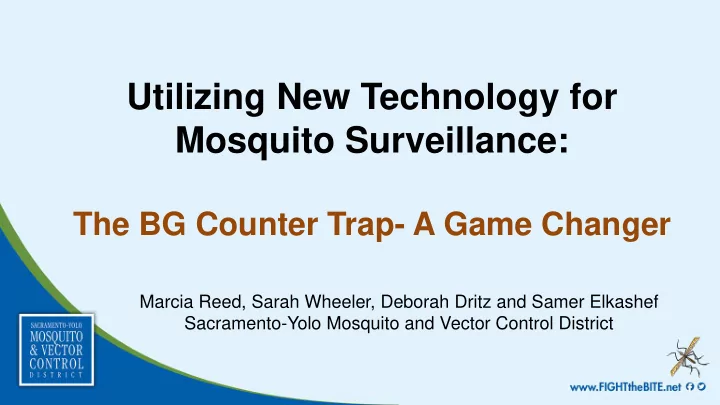

Utilizing New Technology for Mosquito Surveillance: The BG Counter Trap- A Game Changer Marcia Reed, Sarah Wheeler, Deborah Dritz and Samer Elkashef Sacramento-Yolo Mosquito and Vector Control District
Biogents Counter Trap – Solar panel charges battery – Standard BG Sentinel trap w/ CO 2 – Records data every 15 minutes – Wirelessly transmits the data – Remotely change programmable features (on/off, CO 2 flow, etc …) – Differentiates mosquito sized insects from other insects
Total Trap Cost BG Sentinel $190 Counter unit $1475 Web Service $434 Solar System $400 Battery $30 CO2 Tank $100 Total $2629 (Cage Optional for Security)
Past rice adult surveillance program – MMT traps or dry ice can traps used – 4-5 days/week – One FTE for 6 hrs/day (low end $7,392 over 22 weeks) – Treatment plans decided after noon New rice adult surveillance program – BG Counter traps used – 7 days per week data – 1 day per week maintenance – One FTE for 6hrs/week (only $1,848 over 22 weeks) – Data for treatment decisions as soon as work day begins
• Picture of Unit
BG • Map of placement
How accurate ? • Weekly collections • Actual count vs trap recording • Average about 19% difference • 11% difference if large insects included
Culex tarsalis • Rice habitat • Continuous monitoring of populations over the season • Minimal labor to maintain trap
Some sites show the expected activity Hourly activity - Conaway rice site 300 250 Avg. # insects counted 200 150 100 50 0 19:00 20:00 21:00 22:00 23:00 0:00 1:00 2:00 3:00 4:00 5:00 6:00 7:00 8:00 Time • Usual start time of activity – shortly after sunset
Other sites show different activity Hourly activity - Natomas rice site 140.0 120.0 Avg # Insects counted 100.0 80.0 60.0 40.0 20.0 0.0 18:00 19:00 20:00 21:00 22:00 23:00 0:00 1:00 2:00 3:00 4:00 5:00 6:00 7:00 8:00 9:00 Time • Extended activity time – std dev bars show variability of trapping nights
What about urban mosquitoes?
Cx pipiens specifically: • One of two main West Nile Virus vectors • 214 positive pools in 2018 (55% of our “+” pools) • Green belts, parks, urban creeks habitats are the areas of ground based control responses – Last year - over 30,000 acres ULV applications done here – Far majority done at the usual “peak” post sunset time frame
What we found with the BG Counter: Parklite Circle Site- Average Hourly Activity July 19-22, 2018 30 Avg. # Insects Counted 25 20 15 10 5 0 19:00 20:00 21:00 22:00 23:00 0:00 1:00 2:00 3:00 4:00 5:00 6:00 7:00 8:00 Time • Urban/suburban site • Backyard of a house adjacent to a park • Frequently treated via backpack and quad ULV
Bond Rd Elk Grove Site - Average Hourly Activity Aug 10-12, 2018 70 60 Avg. # Insects Counted 50 40 30 20 10 0 19:00 20:00 21:00 22:00 23:00 0:00 1:00 2:00 3:00 4:00 5:00 6:00 7:00 8:00 Time • Another Urban/suburban site • Again shows activity much later in evening than expected • Peak activity actually in the early morning
What this means: • Larger treatment window of mosquito activity is thus indicated • Backpack, quad and truck ULV applications • Temperature inversions not as critical • Spraying under/into canopy commonly • Can perform applications when fewer people present in parks/greenbelts
More data from BG Counter: Trap Counts - Pre Spray versus Post Spray Parklite Circle Site 25 Avg. # insects counted 20 15 pre spray 10 post spray 5 0 19:00 20:00 21:00 22:00 23:00 0:00 1:00 2:00 3:00 4:00 5:00 6:00 7:00 8:00 Time • Urban aerial ULV treatment pre and post trap data • Four days of pre-spray data and two days of post-spray • Visible decrease in mosquito activity
Conclusions: • BG Counter trap provides very useful data • Multiple people can review the data from their computers • Will utilize data to optimize treatments Next Steps: • Integrate weather data • More data at more sites – Cx pipiens & Cx tarsalis – An freeborni & pasture Aedes
Acknowledgments Sac-Yolo Laboratory and Control Staff for trap work, data collection and site selection, maintenance, etc … Michael Weber of Biogents for advice, troubleshooting assistance, etc …
Thank You Contact Information: Marcia Reed mreed@fightthebite.net 916-405-2092 (office) 916-919-2856 (cell)
Recommend
More recommend